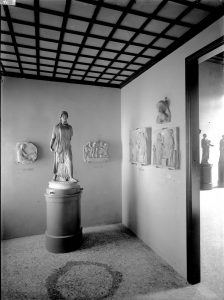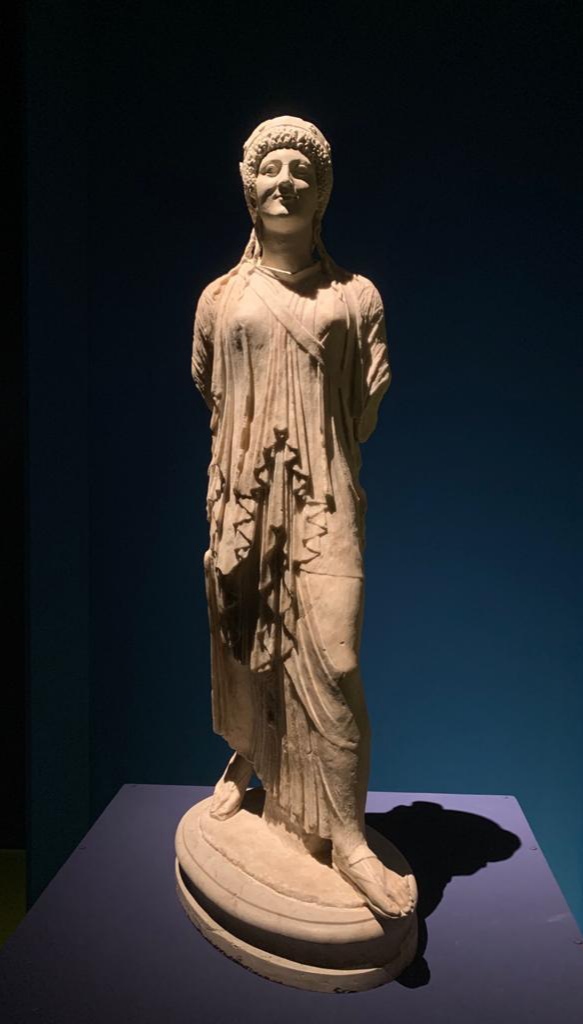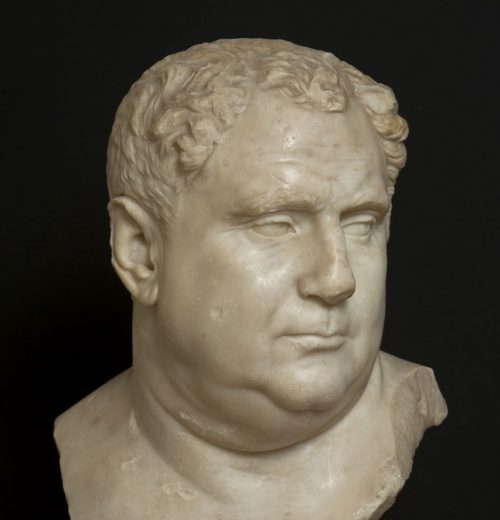
Two heads for the Artemis of Venice
The Archaeological Museum elsewhere
Artemis advances with a large and decisive step, dressed in a long light dress that opens like a fan between her legs and in a cloak that falls to her knees. Her elegant drapery follows the lines of her body; her folds zigzag with decorative grace. The goddess carries what remains of a quiver over her shoulder. Her head, with a rigid archaic smile, is an early 20th-century plaster cast from a statue in the Archaeological Museum of Naples. A diadem embellishes her composed hair, which falls on the shoulders in a few thin locks.
We know three other statues portraying an archaistic Artemis. This one from Venice was already part of the Grimani collection in the 16th century (Inv. 59). In 1760, they found the Artemis of the Museum of Naples in a house in Pompeii. The third was unearthed in 1880 in Castiglione della Pescaia among the remains of a Roman villa; the Maremma Archaeological and Art Museum in Grosseto has exhibited it since 2001. In the same year, the Carabinieri recovered a fourth and last statue, now kept in the Roman National Museum.
The sculptures date back to the second half of the 1st century BC and might be products from the same workshop in Rome. They have the iconography in common: the figure took a step forward, holding one hand outstretched, perhaps to hold the bow, while the other was moving the dress away from the body. Some scholars think they are Roman copies of a 500-480 BC bronze original, presumably the Diana of Segesta mentioned in Cicero’s orations against Verres. Others, on the other hand, consider them refined creations of archaic Roman art.
The existence of four surviving sculptures sharing the same iconography is a sign of the subject’s luck. The style inspired by the Greek art of the archaic period found great favor in Rome during the religious restoration of Augustus. The archaic forms were also popular in the imperial age, used for the statues of the gods when they wanted to highlight the more austere and ancient aspects of their cult.
The story of the restoration and de-restoration of the sculpture in Venice, already in the Grimani collection and the museum since the end of the 16th century, is interesting. They appointed a sculptor of the time to complete the headless statue, which probably arrived from Rome. The Renaissance intervention integrated not only the head but also the right forearm, part of the quiver (lost), the tip of the left foot, and the molded plinth around the ancient base (still in place). Therefore, the head, again on display in the museum these days, is the work of a 16th-century artist-restorer. Modeled on an Aphrodite type, it has a hairdo with a central parting and two bands of hair worn over the head and held in place by a bandage. A second bandage surrounds the top while two curls descend on each side of the neck. Some details denounce its modernity, such as the small mouth, the dimple on the chin, and the engraved pupils facing upwards. One can find the same characteristics in the restored heads that complete some other statues in the Archaeological Museum, formerly in the Grimani collection, for example, that of Leda (Inv. 30) and the so-called Cleopatra (Inv. 53), the latter attributed to the Lombardo workshop.

Renaissance head
At the beginning of the 20th century, during the reorganization of the Royal Archaeological Museum of Venice, whose classical section opened on 25 April 1909, Gherardo Ghirardini and Giuseppe Pellegrini deemed it appropriate to restore the correct iconography of the sculpture, replacing its head with a cast taken from the Artemis of Naples. In Palazzo Ducale, which housed the statuary collection organized according to chronology and style, this little Diana was, in fact, the fulcrum of the first room of the visit itinerary, which took its name from her and displayed on the walls some Attic reliefs from the 5th and 4th centuries BC. The replacement of the Renaissance head (Inv. 381) with a modern plaster «for the benefit of those who will visit the Palazzo Ducale museum to study ancient art there,» as it was said, was not the only expository expedient reserved for sculpture. It stayed on a revolving base to facilitate viewing from all sides.

The Hall of Diana, Royal Archaeological Museum in Palazzo Ducale, early 20th century.
On the occasion of the exhibition #Artemide: one, none, one hundred thousand at the Maremma Archaeological and Art Museum in Grosseto, the statue from Venice underwent careful restoration by Patrizia Toson. It has not only restored legibility to the working of the marble surfaces, now vibrant with light – the original colors that decorated the dress and face are, unfortunately, irretrievably lost – but also restored volume and detail to the modeling of the excellent 20th-century cast, much flattened by a previous deteriorated intervention.
A curious detail: the Gipsoteca of the Museum of Archaeological Sciences and Art of the University of Padua – where Gherardo Ghirardini, Superintendent of Antiquities of the Veneto, taught Archeology from 1899 to 1907 – exhibits a cast, also from the early twentieth century, of the Artemis of Venice still complete with its Renaissance head. Therefore, we believe that the Paduan plaster, made before the de-restoration operation, may have been functional in the preliminary study of the sculpture by the archaeologists who decided to restore its original archaic appearance, «tarnished» by the modern head.
MDP

20th-century cast, Museum of Archaeological Sciences and Art of the University of Padua. Photo with permission of the University of Padua




